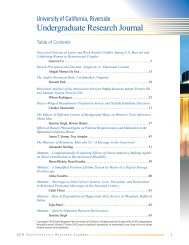2010 - Undergraduate Research, Scholarship and Creative Activity
2010 - Undergraduate Research, Scholarship and Creative Activity
2010 - Undergraduate Research, Scholarship and Creative Activity
You also want an ePaper? Increase the reach of your titles
YUMPU automatically turns print PDFs into web optimized ePapers that Google loves.
evaluated. The ion binding of BSA was<br />
compared to ion binding values of BSA through<br />
modeling <strong>and</strong> in silico methods.<br />
Colorimetric <strong>and</strong> fluorescence detection of<br />
volatile organic compounds using electrospun<br />
nanofibers<br />
The Effects of Proton Pumping on the<br />
Osmotic Pressure of Macromolecular<br />
Crowded Environments<br />
Chris Hale, Bioengineering<br />
Contributor: Devin W. McBride<br />
Mentor: V. G. J. Rodgers<br />
Department of Bioengineering<br />
Macromolecular crowding are solutions that<br />
contain high concentrations of proteins. These<br />
crowded protein solutions are observed in<br />
cellular systems <strong>and</strong> the concentration of total<br />
proteins range from 50-400g/L. The<br />
thermodynamics of cellular systems is extremely<br />
complex <strong>and</strong> thus, difficult to model <strong>and</strong><br />
underst<strong>and</strong> the mechanisms. However, studying<br />
the thermodynamics of crowded protein<br />
solutions in vitro can shed light onto the<br />
mechanisms. The osmotic pressure of crowded<br />
protein systems have been studied for a few<br />
proteins <strong>and</strong> it behaves non-ideally<br />
near-saturation. We developed the free solvent<br />
model which is able to predict the crowded<br />
protein osmotic pressure using only measurable<br />
parameters. The free solvent model is able to<br />
accurately predict the osmotic pressure using the<br />
protein-ion binding <strong>and</strong> protein hydration. To<br />
more accurately model the thermodynamics of<br />
cellular systems, we began to study nonequilibrium<br />
situations, such as proton <strong>and</strong> ion<br />
pumping. Proton pumping occurs in cellular<br />
systems during many processes, two of which<br />
are ATP production during cellular respiration<br />
<strong>and</strong> photosynthesis. To underst<strong>and</strong> how proton<br />
pumping affects the cellular system, we study<br />
the crowded protein osmotic pressure while<br />
varying the pH. To further mimic the cellular<br />
system, we rapidly alter the pH of the solvent<br />
stream using physiological pHs; 4.5, 5.4, <strong>and</strong><br />
7.4. In our studies, bovine serum albumin (BSA)<br />
is the protein of interest due to the extensive<br />
literature about the physiochemical properties,<br />
ion binding, <strong>and</strong> hydration of BSA.<br />
Christopher Hare, Chemistry<br />
Co-author: Bryce Davis, Chemistry<br />
Mentor: Quan Jason Cheng<br />
Department of Chemistry<br />
The development of efficient sensors for the<br />
detection of volatile organic compounds has<br />
gained attention. Conventional approaches can<br />
be time consuming, costly, <strong>and</strong> do not always<br />
result in accumulation of useful data. A<br />
quantitative approach using color <strong>and</strong><br />
fluorescence differentiation of common volatile<br />
organic solvents has been developed. A<br />
polydiacetylene (PDA)-embedded electrospun<br />
fiber mat, prepared with 10,12 pentacosadiynoic<br />
acid-derived diacetylene monomer, displays an<br />
array of solvent sensitive color transitions when<br />
exposed to common organic solvents. The color<br />
transitions can also be measured quantitatively<br />
using fluorescence spectroscopy. The<br />
fluorescence data can be used to differentiate<br />
between solvent samples. Arrays of PDAembedded<br />
nanofibers have been constructed by<br />
electrospinning poly(ethylene oxide) solutions<br />
containing a specific ratio of the diacetylene<br />
monomer. Unique color patterns were developed<br />
when the conjugated polydiacetylene-embedded<br />
fiber mats were exposed to vaporized organic<br />
solvents in a manner which enabled direct<br />
colorimetric differentiation of the tested<br />
solvents.<br />
Geometric Characterization <strong>and</strong> Structure-<br />
Property Relationships in a Heterogeneous<br />
Impact-Tolerant Biomineral<br />
Steven Herrera, Chemical Engineering<br />
Contributors: Garrett Milliron, James Weaver,<br />
Ali Miserez, Elaine DiMasi, Javier Garay,<br />
Hsiao-Yun Milliron<br />
Mentor: David Kisailus, Department of<br />
Chemical <strong>and</strong> Environmental Engineering<br />
Hierarchically structured biominerals are made<br />
from common <strong>and</strong> mechanically unimpressive<br />
constituents, but the spatial distribution of these<br />
elements combine to form ultrastructures which<br />
Fourth Annual UCR Symposium for <strong>Undergraduate</strong> <strong>Research</strong>, <strong>Scholarship</strong> <strong>and</strong> <strong>Creative</strong> <strong>Activity</strong><br />
32














